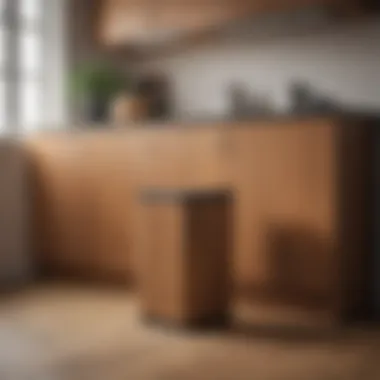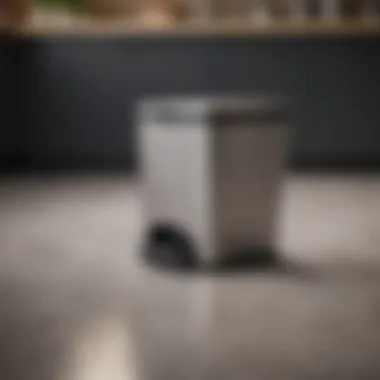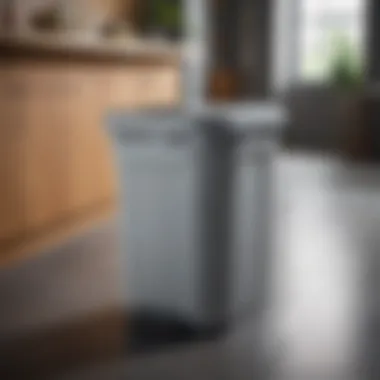Maximizing Efficiency: Space-Saving Kitchen Trash Cans


Intro
In recent years, the kitchen has transformed into a central hub of the home. With this shift, the importance of effective waste management has become more pronounced. Space-saving kitchen trash cans not only address the need for hygiene but also integrate seamlessly into modern design. This article aims to delve into the myriad of options available, highlighting their design, functionality, and the many benefits they bring to contemporary kitchens.
A well-chosen trash can can elevate the kitchen experience by enhancing both aesthetics and operational efficiency. Thus, homeowners and design enthusiasts need to grasp the various factors influencing this choice, from style to material. This guide will help you navigate the options available, ensuring the selection process is as efficient as the trash can you ultimately choose.
Understanding the Need for Space-Saving Solutions
In today's fast-paced world, kitchens often serve multiple purposes beyond mere meal preparation. They are gathering spots for families, spaces for culinary creativity, and sometimes, even mini-offices. As homes become smaller and demands on space rise, maximizing efficiency in every aspect of the kitchen becomes essential. One key element to consider is the trash can. A traditional, bulky trash receptacle can disrupt the flow of a kitchen and occupy valuable real estate that could be used for more functional or decorative elements.
Space-saving kitchen trash cans address this challenge effectively. They not only optimize limited space but also enhance the overall functionality of the kitchen. These trash cans may incorporate innovative designs that allow them to be tucked away neatly, offering a streamlined look that complements modern aesthetics. Furthermore, an efficient waste management solution contributes to a cleaner environment and improved kitchen hygiene, making it an investment worth considering for homeowners.
The Role of the Kitchen in Modern Living
The kitchen has evolved from a simple cooking area into a multifunctional space. It often reflects personal style and serves as a hub for family interaction or social gatherings. As such, any element within the kitchen, including the trash can, should support this multifunctionality. When a trash can is not aesthetically pleasing or occupies too much space, it can detract from the kitchen's overall appeal. Thus, a thoughtfully designed trash can plays a vital role in maintaining both beauty and utility in this critical space.
Challenges of Limited Kitchen Space
Limited kitchen space poses significant challenges for many homeowners. In urban settings, kitchens are often compact, forcing individuals to make strategic design choices. A large trash can can consume space that might otherwise accommodate storage or counter area. In addition to the physical limitations of small kitchens, there is also the psychological effect of crowded spaces. A cluttered kitchen can lead to stress and reduced efficiency in meal preparation.
Opting for a space-saving trash can can alleviate these challenges. By carefully selecting a container that fits snugly into specific areas, homeowners can utilize vertical or hidden spaces effectively. Options like pull-out bins or wall-mounted designs enable not only a more organized environment but also a more pleasant cooking experience.
By understanding the significance of space-saving solutions in the kitchen, particularly regarding trash management, homeowners can make informed choices that enhance both the functionality and aesthetic appeal of their kitchens.
Innovations in Trash Can Design
In an era where space is a premium, the design of kitchen trash cans has evolved significantly to meet both functional and aesthetic needs. Innovations in trash can design focus on optimizing space without compromising utility. They offer solutions that fit seamlessly in modern kitchens while addressing pressing concerns around waste management and organization. The advancements not only enhance the kitchen's efficiency but also contribute to a cleaner environment.
Types of Space-Saving Trash Cans
Pull-out trash cans
Pull-out trash cans are a clever solution for kitchens with limited floor space. These units are designed to slide out from under a countertop or cabinet, making them easy to access while keeping them out of sight when not in use. Their unique characteristic is that they can be customized to fit specific cabinet dimensions, maximizing every inch of available space.
One significant advantage is their ability to conceal waste, maintaining the kitchen's aesthetic appeal. However, one should consider the potential disadvantage of installation complexity, which may require specific cabinetry setups for proper functioning.
Wall-mounted bins
Wall-mounted bins represent another effective way to save space in kitchens. Installed directly on the wall, these bins free up valuable floor area and can be placed at eye level for easy disposal. Their key characteristic is versatility; they can be adjusted to different heights based on user preference.
These bins often come with a lid, which helps to contain odors and keep the kitchen looking neat. However, an important disadvantage to note is that they might require wall drilling, which can be a concern for those living in rental properties.
Under-sink models
Under-sink models take advantage of an often-overlooked space. These trash cans are specifically designed to fit beneath the sink, utilizing the area that typically goes unused. The major benefit of under-sink models is that they are out of sight and help maintain a clean kitchen look.
Moreover, these designs generally offer features such as soft-close lids to prevent noise when disposing of waste. However, a potential disadvantage is that they may be harder to access, especially if under-sink plumbing takes up considerable space.
Smart Trash Cans
Sensor-activated lids
Sensor-activated lids add a layer of convenience to trash disposal. With a simple wave of the hand, users can open the bin without touching the surface. This feature promotes hygiene and reduces the spread of germs, which is vital in a kitchen environment. The key characteristic of these bins is their hands-free operation, making them a practical choice for busy households.


However, one should consider the disadvantage of reliance on batteries or a power source, which may require periodic maintenance or replacement.
Waste segregation features
Waste segregation features are increasingly popular as environmental awareness grows. Many modern trash cans come with multiple compartments designed for separating recyclables from general waste. This design encourages better recycling habits and simplifies waste management at home. The important key characteristic of these bins is their efficiency in handling various types of waste, thus contributing positively to sustainability efforts.
An associated advantage is that they help households comply with local recycling laws. However, a potential disadvantage is the need for more space to accommodate the additional compartments, which may not suit every kitchen layout.
The evolution of kitchen trash cans demonstrates how even small household items can significantly impact efficiency and sustainability.
Choosing the right space-saving trash can hinges on understanding the unique advantages and limitations of each design approach. It is important to consider not just functionality, but how the chosen option complements the overall kitchen space.
Key Features to Consider
When selecting a space-saving kitchen trash can, several key features must be assessed. These features not only enhance functionality but also the overall efficiency of your kitchen. Homeowners and design enthusiasts should consider factors such as capacity and size, material durability, and ease of cleaning. Each aspect contributes to a more streamlined waste management process. Understanding these components will guide you to make informed decisions that align with your kitchen's specific needs.
Capacity and Size
Capacity and size are crucial factors when it comes to trash cans in your kitchen. A well-chosen trash can fits seamlessly into your kitchen without overwhelming the space. Too large, and it may inhibit movement; too small, and it becomes impractical for a family’s waste needs.
This makes it vital to assess the typical volume of waste your household produces. A smaller household might benefit from a compact size, while larger families may require a larger capacity. Additionally, space constraints in your kitchen dictate which dimensions will work best.
Important considerations include:
- Footprint: Ensure the trash can's dimensions align well with available space.
- Height: Sometimes a higher can can fit better in a corner rather than a wide option.
- Accessibility: Think about how easily you can access the can for quick disposal.
Material Durability
Material durability plays a considerable role in the overall longevity and functionality of trash cans. Two primary materials are commonly used – stainless steel and plastic.
Stainless Steel Advantages
Stainless steel trash cans are favored for their durability and sleek look. This material's key characteristic is its resistance to dents and rust, making it a long-lasting choice.
- Unique Feature: Stainless steel is non-porous, making it more hygienic as it does not harbor bacteria.
- Advantages: It is also relatively easy to clean, blending well in modern kitchens.
However, some may find stainless steel more expensive compared to plastic alternatives. In terms of aesthetics and maintaining a clean appearance, stainless steel stands out as a beneficial option in stylish kitchen designs.
Plastic versus Metal Options
Plastic trash cans are another popular choice, largely due to their lighter weight and lower price. A key characteristic of plastic is its versatility in colors and styles. They can seamlessly fit into various decor schemes.
- Unique Feature: Many plastic models come with features like foot pedals for hands-free access.
- Advantages: Plastic tends to be less expensive and easier to maneuver.
On the other hand, plastic may not have the same durability as stainless steel. It can scratch and stain over time, leading to maintenance challenges. Hence, choosing between these materials depends on your budget and preferences for durability versus cost-efficiency.
Ease of Cleaning
Ease of cleaning a trash can is an essential aspect that affects both hygiene and usability. In kitchens, where cleanliness is vital, the cleaning process can be a deciding factor for many.
Look for cans with removable liners or those that feature smooth surfaces. A trash can that can be easily wiped down or rinsed out will save time in the long run. Additionally, consider the design; cans with a simple latch mechanism are easier to manage than more complex designs. By prioritizing ease of cleaning, you can ensure that your space remains tidy and free from unpleasant odors.
Aesthetic Considerations


In today's fast-paced world, a well-designed kitchen not only serves as a functional space but also as an important aspect of home aesthetics. The inclusion of a trash can may seem trivial, yet its design significantly shapes the overall kitchen environment. Space-saving kitchen trash cans provide an efficient solution that merges functionality with visual appeal. The right trash can enhances kitchen decor while efficiently managing waste.
Integrating Trash Cans into Kitchen écor
When considering trash can integration into kitchen design, the emphasis should be on making this essential item visually compatible with other elements in the space. A trash can that seamlessly fits into the cabinetry can conserve space and offer a clean, streamlined look. For instance, pull-out models that are concealed behind cabinet doors maintain a clutter-free environment.
Here are some strategies to consider when integrating trash cans into kitchen decor:
- Match Materials: Choose a trash can with a finish or texture that complements countertops or cabinet finishes.
- Consider Shape: Sleek, modern shapes tend to work well in contemporary spaces, while more traditional shapes might suit classic kitchens.
- Focus on Storage: Highlight trash cans that offer additional storage for compostable or recyclables, blending functionality with style.
Ultimately, the goal is to minimize visibility and create a space that feels organized. A carefully chosen trash can should not just be another object but rather a thoughtful addition to the kitchen’s aesthetic.
Color and Finish Options
The color and finish of a trash can play a crucial role in how it fits into the kitchen. Many choose stainless steel for its sleek look and durability, while others may prefer colored finishes to add a pop of personality. There are a few considerations to keep in mind:
- Neutral Tones: White, black, or stainless steel offers versatility and can blend with various decors.
- Bold Colors: If the kitchen color palette is subtle, a vibrant trash can may serve as a focal point.
- Textures: Matte finishes can provide a modern touch, while glossy finishes offer a more polished appearance.
Choosing the right color and finish is not merely for aesthetics; it determines the trash can's ability to camouflage or stand out in a kitchen setting. Finding the balance between aesthetic value and functionality will ensure the trash can is both a practical and stylish addition to the kitchen.
Sustainability and Eco-Friendly Options
In recent years, sustainability has emerged as a focal point in kitchen design and functionality. Embracing eco-friendly solutions is not just a trend but a necessity for responsible living. Space-saving kitchen trash cans play a vital role in this movement by offering practical waste management options that align with sustainable living practices. The integration of eco-friendly materials and recycling solutions makes it easier for homeowners to minimize waste and make a larger impact on the environment.
Adopting these eco-friendly practices in the kitchen benefits both the homeowner and the planet. For instance, when you use bins designed for recycling or composting, you create a system that encourages waste segregation. This can significantly reduce the amount of waste that ends up in landfills, ultimately benefiting the environment. Understanding these components is crucial for anyone looking to enhance their kitchen's efficiency while promoting sustainability.
Recycling and Composting Solutions
Recycling and composting are two essential practices that can dramatically improve waste management in the kitchen. Space-saving trash cans specifically designed for these purposes typically come with separate compartments. By having distinct bins for recyclables and organic materials, users can easily sort waste, leading to higher recycling rates and effective composting.
- Recycling bins: These bins are suitable for materials such as paper, plastics, and metals. They often include features like color-coded lids that make it simple to identify the correct bin. Some models are even labeled to guide users through the recycling process, making it more accessible and efficient.
- Compost bins: Composting organic waste, such as food scraps and yard waste, is another way to reduce landfill contributions. A good compost bin can take up minimal space under the sink or in a corner of the kitchen. This not only helps in recycling but also enriches the soil if you engage in home gardening.
- Educational Tools: Many modern trash cans come equipped with educational tools or apps that assist homeowners in understanding what can be recycled or composted, thus enhancing their commitment to sustainable waste management.
Materials and Environmental Impact
The choice of materials used in kitchen trash cans significantly influences their environmental impact. Opting for sustainable materials can reduce the overall ecological footprint.
- Recycled Materials: Many trash cans today are manufactured from recycled plastics or metals. This not only decreases the demand for virgin materials but also promotes the recycling industry, creating a circular economy.
- Bamboo and other sustainable options: Some manufacturers are now incorporating bamboo or other sustainably sourced materials into their designs. Bamboo, for example, is biodegradable and renewable, making it a durable and eco-friendly choice.
- Low-Impact Manufacturing Processes: Companies that focus on minimizing environmental harm during production often choose processes that use less water and energy or that create less waste. Investing in trash cans made through such methods can lead to a more sustainable kitchen setup.
"By choosing eco-friendly trash cans, we not only improve efficiency but also contribute positively to the environment. Every small choice matters."
Selecting the Right Space-Saving Kitchen Trash Can
Choosing the appropriate space-saving kitchen trash can is paramount for optimizing both functionality and aesthetics in modern kitchens. The right model not only addresses the practical concerns of waste management but also aligns with the overall design. This selection process involves evaluating several critical aspects such as your kitchen layout and budget.
Assessing Your Kitchen Layout
Assessing the kitchen layout is a fundamental first step when selecting a trash can. This process requires a careful examination of the available space and how it influences the type of trash can that can be accommodated.
Start by measuring key dimensions. Space-saving solutions like pull-out trash cans tend to fit seamlessly into cabinets, while wall-mounted bins can save valuable floor space. The distance to frequently used areas, like the sink or prepping counter, is also important. A trash can that is easy to access encourages proper disposal habits. If counter space is at a premium, consider models that can slide under the sink or mount above the countertop.
Another element to analyze is how the trash can interacts with existing kitchen accessories. Harmonizing the trash can with appliances or storage solutions enhances the kitchen's functionality while maintaining visual coherence.
Budget Considerations


Budget is another critical factor in the decision-making process. The market offers a wide range of models with varying prices, so it is essential to establish a budget that reflects your needs. Cheaper options may initially seem attractive, but they can lack durability and functionality. Investing in a more expensive model may yield better long-term savings through durability and reduced need for replacements.
When budgeting, consider the following elements:
- Material quality: Stainless steel options often come at a higher price but provide greater resilience against wear.
- Features: Trash cans equipped with smart technology or unique designs might cost more but offer added convenience and efficiency.
- Size and capacity: Larger models can accommodate more waste, potentially saving costs related to frequent replacements or disposal fees.
"In a well-designed kitchen, every element, including the trash can, plays a crucial role in enhancing functionality and aesthetics."
Maintenance and Care Tips
Maintaining a clean and efficient kitchen trash can is essential for both hygiene and functionality. Regular care not only prolongs the lifespan of the trash can but also ensures that it remains a pleasant addition to your kitchen environment. A well-maintained trash can prevents odors and pest problems, contributing to overall kitchen health. Investing time in maintenance can significantly enhance the daily experience of managing waste, keeping your space organized.
Regular Cleaning Routines
Establishing a regular cleaning routine is vital for keeping your space-saving kitchen trash can in optimal condition. Depending on usage frequency, you should clean it at least once every week or bi-weekly. Here are the steps for an effective cleaning routine:
- Empty the Trash Can: Always start by emptying the contents. Ensure that you dispose of the trash properly to avoid any cross-contamination.
- Rinse and Scrub: Using warm soapy water, rinse the interior and exterior of the trash can. For stubborn stains or residues, a non-abrasive sponge can ensure that the surface is clean without scratches.
- Use Disinfectant: After scrubbing, apply a disinfectant to kill germs and bacteria. Allow it to sit for a few minutes to maximize its effectiveness.
- Dry Thoroughly: After cleaning, make sure to dry the trash can completely to avoid any moisture which can lead to mold growth.
- Replace Liners: If your trash can uses liners, replacing them should be done after every empty. This reduces odors and keeps the internal space clean.
By following these steps, you create a hygienic space that promotes efficiency when managing kitchen waste.
Troubleshooting Common Issues
Even the best-designed trash cans can experience issues over time. Recognizing and resolving these common problems can aid in maintaining the can's efficacy and overall function:
- Odor Build-up: If you notice unpleasant smells, make sure to clean the can thoroughly and consider including odor-absorbing solutions like baking soda in the bottom to combat future smells.
- Clogs in Sensor Trash Cans: For smart trash cans with sensor-activated lids, ensure the sensors are clean and free from any blocking debris. Regularly check and remove any obstructions to facilitate smooth operation.
- Lid Malfunction: If the lid does not close properly or opens unexpectedly, inspect the hinges for any built-up debris or misalignment. Sometimes, a gentle adjustment or a clean can fix the issue.
- Rust or Deterioration: For metal trash cans, be proactive to prevent rust. Regularly check for scratches or wear and promptly treat any issues with an appropriate rust-resistant spray.
By being aware of these potential issues and addressing them promptly, you can maintain your space-saving kitchen trash can in optimal working order. Regular care ensures that your investment continues to contribute to a clean and organized kitchen.
Future Trends in Trash Can Design
The design of kitchen trash cans may seem basic, but ongoing trends highlight the importance of innovation and efficiency in this often-overlooked aspect of kitchen utility. Future trends in trash can design are intended to merge function with style, fulfilling the dual roles of waste management and decor enhancement. This article section focuses on emerging technologies and design innovations expected to shape the future of trash cans, catering to the evolving needs of modern kitchens.
Emerging Technologies
Innovations in technology are revolutionizing how trash cans are manufactured and utilized. Sensor-activated models demonstrate how automation can streamline kitchen tasks. These cans open with a wave of the hand, minimizing contact with surfaces and enhancing hygiene. Smart features such as these are designed not just for convenience but also for maximizing the efficiency of waste disposal.
Consider the importance of connectivity in smart homes. Some trash cans integrate with home automation systems, allowing users to monitor capacity levels via apps. These cans can send alerts when it is time to empty them. This integration prevents overflow and enhances the kitchen's overall efficiency. Other advancements include odor control systems that use carbon filters, ensuring a more pleasant environment in small kitchen spaces.
Design Innovations on the Horizon
As aesthetics become increasingly relevant in home design, new trends in appearance and functionality are emerging in trash can design. Manufacturers now focus on sleek, modern appearances that complement kitchen decor while promoting space savings.
Key design features include:
- Shape Optimization: Unique shapes, such as triangular or oval bins, maximize corner spaces and allow for easier placement in tight areas.
- Material Advances: Materials like recycled plastics or bamboo-based composites reflect sustainability trends, appealing to eco-conscious consumers while providing durability.
- Color Variety: The introduction of a wider palette of colors and finishes allows homeowners to select trash cans that harmonize with their kitchen aesthetics.
"The trash can of the future will not just conceal waste; it will be an integral part of a well-designed kitchen."
The End
In this final section, we reflect on the significance of a thoughtfully designed trash can in modern kitchens. A kitchen trash can is no longer just a waste receptacle; it embodies functionality and style. Homeowners and design enthusiasts alike must recognize the importance of integrating efficiency into their kitchen spaces. A well-chosen trash can not only serves its basic purpose but also contributes to the overall aesthetic of the kitchen.
The Impact of a Thoughtfully Designed Trash Can
The inclusion of a space-saving trash can can dramatically improve kitchen workflows. It can streamline waste management, reduce clutter, and maintain a cleaner environment. When selecting a trash can, consider how its design interacts with your kitchen layout. A can that complements existing elements can elevate the room's appearance.
Moreover, a professional-grade trash can equipped with features like sensor-activated lids can heighten convenience. This innovation minimizes contact with the receptacle, promoting hygiene. Enhanced sanitation is especially crucial in busy kitchen settings, where food preparation is common.
In combination, aesthetic appeal and functionality create a harmonious kitchen ecosystem. A space-saving trash can signals an owner's commitment to both practicality and design. By investing in a high-quality model, homeowners can optimize their kitchen's efficiency, enhance its visual appeal, and take proactive steps toward sustainable waste management. As we have explored throughout this article, every detail matters when addressing efficiency in kitchen design.















